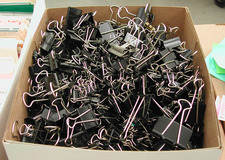According to Wikipedia, in 1910, Louis Baltzley invented the binder clip, Patent # 1,139,627, so that his father Edwin no longer had to bind his manuscripts by sewing the pages together through holes punched in the pages (which was the standard method in the day).
 In more recent times, the binder clip is commonly used in offices of all types to bind large volumes of paper together. In the case of the WAM Files – the working administrative records kept and contained by Gallery/Museum/WAM employees – binder clips were used to organize and contain such items as lengthy grant applications, full sets of label text for exhibits, duplicate copies of press releases, sets of photographs, etc…
In more recent times, the binder clip is commonly used in offices of all types to bind large volumes of paper together. In the case of the WAM Files – the working administrative records kept and contained by Gallery/Museum/WAM employees – binder clips were used to organize and contain such items as lengthy grant applications, full sets of label text for exhibits, duplicate copies of press releases, sets of photographs, etc…
In our pursuit of minimal-level processing, binder clips were removed from the files, resulting in a growing bounty of fasteners.
As I began to encounter CDs, DVDs, and disks of all shapes and sizes during processing, I pondered over the fate of binder clips as offices adopt digital processes and searched for possible additional uses for the clips. To my surprise, some very ingenious do-it-yourselfers have recorded videos on how to make an iPhone Binder Clip Dock to fasten-bind-clip their digital devices in place.
If only I had an iPhone… imagine what I could do with all of these binder clips!